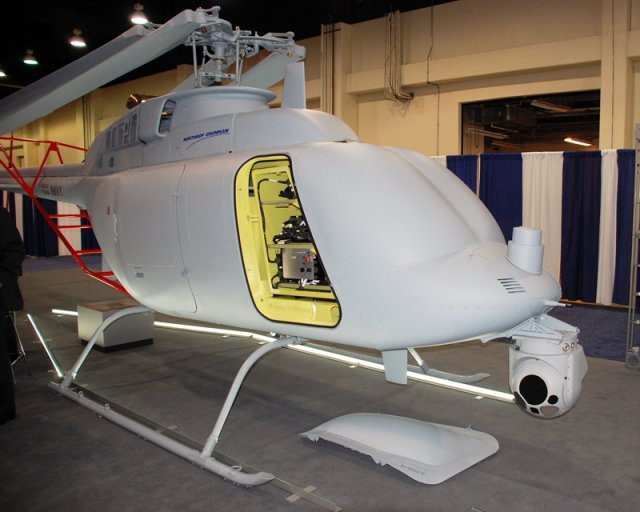 A full scale mock-up of Northrop Grumman’s MQ-8C, the unmanned platform that is to succeed the MQ-8B, was on show earlier this month at the Navy League’s Sea-Air-Space exposition at National Harbor, Md.
A full scale mock-up of Northrop Grumman’s MQ-8C, the unmanned platform that is to succeed the MQ-8B, was on show earlier this month at the Navy League’s Sea-Air-Space exposition at National Harbor, Md.
The MQ-8C is built around the Bell 407 helicopter while the MQ-8B was originally modeled around the Schweizer 333 platform (UTC absorbed Schweizer in August 2004 and the company is now a subsidiary of Sikorsky).
Michael Furqua, director of business development tactical unmanned systems, said of the MQ-8C: “This is the rotary wing UAS of the future. It will have 14 hours endurance and triple the payload of the MQ-8B—that’s 600 lbs.” The MQ-8B has an endurance of around eight hours with a 170-lb payload.
Fuqua said that the U.S. Navy currently operates 28 MQ-8Bs. The UAS has seen service in Afghanistan since May 2011, as well as Libya and Africa with AFRICOM (U.S. Africa Command). Missions have focused on Intelligence, Surveillance and Reconnaissance (ISR) operations as well as over-watch with daily operations sometimes reaching up to 17 hours. Deployments have reportedly exceeded 500 flight hours and by the end of March 2013 the whole fleet had exceeded 8,000 flight hours. Ships such as the USS Robert Bradley have been conducting Fire Scout operations.
Although there has been widespread international interest in Northrop Grumman’s MQ-8B/C program, international export is restricted by the Missile Technology Control Agreement (MTCA), under which UAS are classified. Fuqua said that there were potential exceptions within this understanding depending on the country.
The MTCA is self-described as an “informal and voluntary association of countries which share the goals of non-proliferation of unmanned delivery systems capable of delivering weapons of mass destruction.” Within its classifications is the following: “Category I items include complete rocket and unmanned aerial vehicle systems (including ballistic missiles, space launch vehicles, sounding rockets, cruise missiles, target drones, and reconnaissance drones).”
Fuqua added that, “porting architecture from the MQ-8B to the MQ-8C is the key to success—and with non-recurring costs.”
In March the U.S. Navy awarded Northrop Grumman a $71-million contract for a further six MQ-8Cs (bringing the total on order to 14) with a target fleet size of 30 of the larger Fire Scouts. However, sequestration cuts look to reduce the number of MQ-8 UAS purchased over the next few years as follows: FY13 – six; FY14 – one; FY15 – five; FY16 – eight; FY17 – two; and FY18 – two (source: Department of the Navy FY14 President’s Budget, April 10, 2013).
Photo: MQ-8C mock-up at the Navy League’s Sea-Air-Space Expo – Andrew Drwiega
Source: Aviation Today
